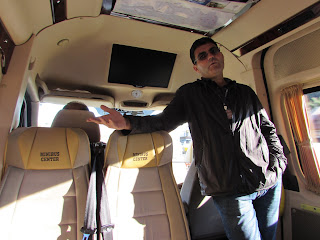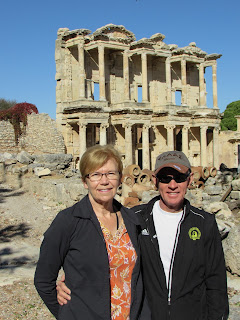The port of Kusadasi is the primary port for accessing the ancient site of Ephesus, just a 20 minute drive away. It is a seaside resort area and Turkey's second busiest cruise destination (after Istanbul).
Again we are in a group of 8 people from our ship touring with a guide from the company Hello Ephesus. The tour was originally reserved by someone who had to cancel the cruise. I volunteered to take over as the one who would be the contact for the tour company. And it worked out very well.
We met our guide, Citen (pronounced Cheten) at 8;15 am as our group left the ship. As we traveled to Ephesus, Citen talked about the history of Turkey, the people, the politics and a little about himself and family.
 |
| Citen our guide |
The area was first settled around 1000 B.C. Over the years the city grew as a sea port and as the worship center of the goddess Artemis. It was under Roman rule that Ephesus reached its peak. By 100 A.D. it had become a city of marble buildings and grand monuments. The ruins there today are mostly from the first and second centuries A.D.
 |
| Ephesus today |
 |
| Ephesus during the Golden Age |
We started our tour in the State Agora, which was an open-air courtyard for shoppers and a place to gather to talk to neighbors.
There is little left of any buildings in the agora but there is evidence of extensive plumbing. Ephesus had one of the ancient world's most sophisticated public waterworks systems. There probably was a main reservoir here at the high end of the city and water flowed through the clay pipes down to the city's fountains and the homes of the wealthy.
 |
| Clay pipes for the water system |
The Odeon dates from about 150 A.D. It was an indoor theater as it once had a wooden roof. It seated about 1,500 people and was mostly used as a weekly meeting place for the city council.
The Prytaneion was a kind of town hall. It was from here that a committee made decisions about city administration. As this is where the "eternal flame" was kept, it was one of the city's most important sites. Ephesus made sure this eternal flame always was lit as it guaranteed prosperity--until paganism was outlawed in 395 A.D.
 |
| Prytaneion |
This is the Nike frieze, which once topped a gate. It depicts the Greek goddess Nike giving the wreath of victory to the Romans.
We walked down Curetes Road. It once had statues, fountains, arches and shops lining the street.
Trajan's Fountain is a huge reservoir that was a public fountain. The wealthy had indoor plumbing but everyone else used fountains like this for their source of water.
The Temple of Hadrian was built to honor the Emperor who came to visit from Athens. It has a beautiful arch on the front facade .
 |
| The Temple of Hadrian |
The latrine room features marble seating surrounding an open-air courtyard with a fountain. Only the wealthy could afford private bathrooms. Everyone else used the public latrines. It was often a social event with seats for 40. A constantly flushing stream of water ran beneath the seats taking waste to a sewer. Along the floor in front of the seats was a second stream with clean water for washing.
We then entered the Terrace Houses, located inside a modern building to protect seven three-story homes each with its own courtyard and elaborate decorations. They represent the lifestyle of the wealthy Ephesians. They were excavated in 1999 and opened to visitors in 2006.
We saw beautifully restored mosaic floors...
 |
The buildings and decor date from the early Roman Imperial period--the first 2 centuries after Christ.
A shopping list was found...
After leaving the Terrace Houses complex, we walked to the Library of Celsus. It was the third-largest library of the ancient world with some 12,000 volumes. It was named after a well-read governor of the province whose son built the library as a mausoleum in his honor in 123 A.D.
The walls and floors inside the library were marble.
This large market place was the main shopping mall of Ephesus. The carved marble slabs out front of the stores pictured what each shop sold.
 |
| An Olive Oil store? |
There is still a lot of Ephesus that has yet to be excavated. The hill on the right side of the photo below has not been excavated. There will be much more to see in the future.
We spent about 3 hours at Ephesus and Cetin was a great guide. He has a background in archeology and was very knowledgeable on the ruins of Ephesus. Being with a small group made it easy to ask questions and hear Cetin's response.
We got a chuckle out of this sign outside a store as we were leaving Ephesus.
Leaving Ephesus we traveled to the town of Selcuk. Along the way we stopped at what once was the Temple of Artemis, the goddess of Ephesus. Built in the 6th century B.C., the spectacular Temple of Artemis was one of the Seven Wonders of the Ancient World. Only a single pillar of the temple survives today. It once had 127 columns.
Surprise! Our next stop was at a Carpet Weaving School. Just can't visit Turkey without seeing a carpet weaving demonstration, right?
We first saw a demonstration of the actual weaving....it can take about a year to weave some of the carpets.
Then we were shown how the silk is harvested from the silkworm cocoons. The cocoons are soaked in water and then a brush catches the silk threads and they are put through a machine that unwinds all the cocoons.
And the silk threads are made into skeins of yarn and dyed for the carpets.
We then were ushered into a room and offered either Turkish coffee, wine, beer, or tea. We chose poorly and chose the Turkish wine. It was awful. I understand the Turkish coffee was pretty good, but very strong.
As we sipped, dozens of carpets were laid out before us. The men would throw out a rolled carpet and then spin it around to show how the colors changed in the light. They were absolutely beautiful, but way too expensive for us to even consider purchasing. The experience was actually very interesting and there was no pressure to buy anything.
Next was a typical Turkish lunch provided by the Carpet Weaving School.
Then it was off to the Ephesus Museum where the artifacts from Ephesus are shown. It was a spectacular exhibit, but we had so little time to see it all.
Some of these coins date back to the 6th century B.C.
This is a bust of Zeus
After breezing through the museum, it was time to head back to the port and bid farewell to Cetin.
It was a wonderful day of siteseeing...a lot to absorb but so well worth it! Ephesus was a fascinating site to see and learn about the lifestyle of the people 2,000 years ago.
Next port....Santorini, a Greek island
















































No comments:
Post a Comment